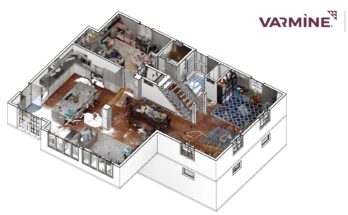A Building Information Modeling (BIM) Execution Plan is a crucial document that outlines the procedures, standards, and guidelines to be followed during the BIM process. It acts as a guide for all stakeholders involved in the construction project, including architects, engineers, contractors, and owners. The plan ensures that all parties are working together with the same set of expectations and goals, promoting collaboration and communication.
The BIM Execution Plan serves as a roadmap for the entire project, ensuring that all parties are following the same standards and protocols. It outlines the roles and responsibilities of each team member, including how they will work together to achieve the project goals. This helps to avoid confusion and conflicts, ensuring that everyone is on the same page. In this article, we will discuss tips and best practices for creating a successful BEP.
Steps to Creating a Comprehensive BIM Execution Plan
A Building Information Modeling (BIM) Execution Plan is a document that outlines the requirements and responsibilities for a successful BIM project. Here are the steps to creating a comprehensive BIM Execution Plan:
Define the BIM Goals and Objectives: Define the goals and objectives of the BIM project. This will help to ensure that everyone involved in the project is aligned with the same goals and objectives.
Identify the Stakeholders: Identify all the stakeholders in the project, including the owner, designers, contractors, and subcontractors. This will help to ensure that everyone is aware of their roles and responsibilities in the project.
Determine the Level of Detail (LOD): Determine the level of detail (LOD) required for the project. This will help to ensure that everyone knows the level of detail required for the project and will help to avoid any misunderstandings.
Establish the BIM Execution Plan (BEP): Establish the BIM Execution Plan (BEP) that outlines the specific requirements for the BIM project. This will help to ensure that everyone knows what is required for the project and will help to avoid any misunderstandings.
Define the BIM Workflow: Define the BIM workflow that will be used in the project. This will help to ensure that everyone knows the steps involved in the BIM process and will help to avoid any confusion.
Establish the BIM Schedule: Establish the BIM schedule for the project. This will help to ensure that everyone knows the timeline for the project and will help to avoid any delays.
Leveraging Technology for Successful BIM Execution Planning
It is a process that involves the use of technology to design, construct and manage buildings and infrastructure. BIM Execution Planning (BEP) is the process of defining how BIM will be used on a project. Leveraging technology can help ensure a successful BIM execution planning process.
Use BIM software: BIM software like Revit, ArchiCAD, or Bentley can help in the creation of a digital model of the building or infrastructure. This software can help automate tasks, reduce errors, and ensure consistency across the project.
Use cloud-based technology: Cloud-based technology can help in the management of data and collaboration among team members. It allows for real-time access to project information, reducing delays and improving efficiency.
Develop a BIM execution plan: The BIM execution plan outlines how BIM will be used on the project. It includes the roles and responsibilities of team members, the level of detail required, the software and technology to be used, and the data management protocols.
Use 4D and 5D BIM: 4D BIM adds the dimension of time to the model, while 5D BIM adds cost information. These tools can help in the planning and management of construction schedules and budgets.
Use laser scanning technology: Laser scanning can help in the creation of an accurate as-built model. This technology can be used during the construction process to ensure that the building or infrastructure is being constructed according to the digital model.
Use mobile technology: Mobile technology can help in the capture and sharing of information in real-time. It can also help in the management of construction activities, safety inspections, and quality control.
Use virtual and augmented reality: Virtual and augmented reality can help in the visualization and communication of design intent. This technology can be used to simulate construction processes and identify potential problems before construction begins.
Benefits of a Successful BIM Execution Plan
A successful Building Information Modeling (BIM) Execution Plan can provide several benefits, including:
Increased efficiency: A BIM Execution Plan provides a roadmap for the entire project team, helping to streamline workflows and improve collaboration between stakeholders. This can lead to increased efficiency in project delivery.
Improved coordination: BIM enables multidisciplinary coordination between architects, engineers, and contractors. With a well-executed BIM Execution Plan, project team members can identify and resolve potential conflicts early in the design process, reducing costly rework and delays during construction.
Better cost control: With a BIM Execution Plan, project teams can accurately estimate costs and quantities for materials and labor. This helps to control costs and reduce waste during construction.
Enhanced visualization: BIM provides a 3D digital model that can be used to visualize the project at different stages of development. This enables stakeholders to better understand the design intent and make more informed decisions.
Improved quality control: A BIM Execution Plan includes a comprehensive quality control plan that outlines the standards and procedures for model development, review, and approval. This ensures that the final deliverables meet the project requirements and are of high quality.
Conclusion
In conclusion, creating a successful BIM Execution Plan requires careful planning and coordination among all stakeholders involved in a project. By following the tips and best practices outlined in this article, project teams can effectively implement BIM and achieve better project outcomes.




